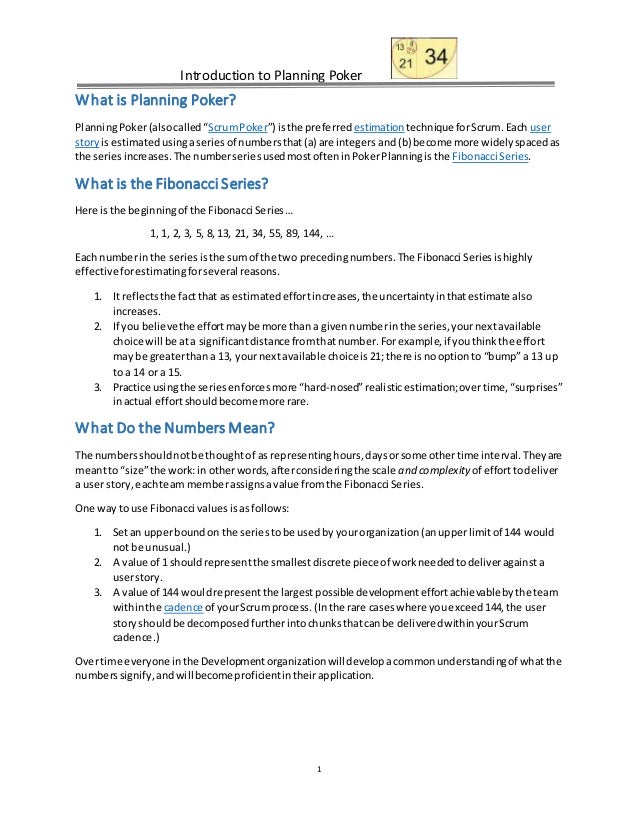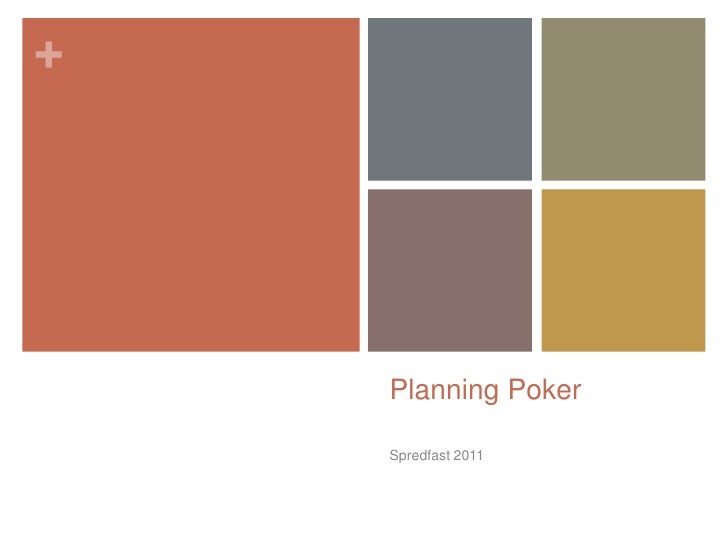Planning Poker Slideshare
Planning Poker® is the fun, easy way for your team to effectively plan and execute a sprint planning session. This free online scrum tool encourages collaboration and planning for distributed agile teams. Through lively discussion, your team will create more accurate estimations for healthier sprints. At first blush, this may appear to be a lot of work with little value. In practice, this is a very quick and simple exercise and it gets you to a decision point pretty quickly. The fact that it is a system makes it predictable, and the 10 minutes it takes to learn and implement will be recouped in your first sprint planning session.
Planning poker, also called Scrum poker, is a consensus-based, gamified technique for estimating, mostly used to estimate effort or relative size of development goals in software development. In planning poker, members of the group make estimates by playing numbered cards face-down to the table, instead of speaking them aloud. The cards are revealed, and the estimates are then discussed. By hiding the figures in this way, the group can avoid the cognitive bias of anchoring, where the first number spoken aloud sets a precedent for subsequent estimates.
Planning poker is a variation of the Wideband delphi method. It is most commonly used in agile software development, in particular in Scrum and Extreme Programming.
The method was first defined and named by James Grenning in 2002[1] and later popularized by Mike Cohn in the book Agile Estimating and Planning,[2] whose company trade marked the term [3] and a digital online tool.[4]
Process[edit]
- After the card flip, Planning Poker® will average the scores of the cards played and round them up to the next card in the Dealer-chosen sequence. You can accept the average and move along to the next story, saving the agreed-upon total, or you edit the score to reflect something else, or reset the round to try effort-pointing again.
- Planning is present in all types of organisations, households, sectors, economies, etc. We need to plan because the future is highly uncertain and no one can predict the future with 100% accuracy, as the conditions can change anytime. Hence, planning is the basic requirement of any organization for the survival, growth and success.
Rationale[edit]
The reason to use planning poker is to avoid the influence of the other participants. If a number is spoken, it can sound like a suggestion and influence the other participants' sizing. Planning poker should force people to think independently and propose their numbers simultaneously. This is accomplished by requiring that all participants show their card at the same time.
Equipment[edit]
Planning poker is based on a list of features to be delivered, several copies of a deck of cards and optionally, an egg timer that can be used to limit time spent in discussion of each item.
The feature list, often a list of user stories, describes some software that needs to be developed.
The cards in the deck have numbers on them. A typical deck has cards showing the Fibonacci sequence including a zero: 0, 1, 2, 3, 5, 8, 13, 21, 34, 55, 89; other decks use similar progressions with a fixed ratio between each value such as 1, 2, 4, 8, etc.
The reason for using the Fibonacci sequence instead of simply doubling each subsequent value is because estimating a task as exactly double the effort as another task is misleadingly precise. A task which is about twice as much effort as a 5, has to be evaluated as either a bit less than double (8) or a bit more than double (13).
Several commercially available decks use the sequence: 0, ½, 1, 2, 3, 5, 8, 13, 20, 40, 100, and optionally a ? (unsure), an infinity symbol (this task cannot be completed) and a coffee cup (I need a break, and I will make the rest of the team coffee). The reason for not exactly following the Fibonacci sequence after 13 is because someone once said to Mike Cohn 'You must be very certain to have estimated that task as 21 instead of 20.' Using numbers with only a single digit of precision (except for 13) indicates the uncertainty in the estimation. Some organizations[which?] use standard playing cards of Ace, 2, 3, 5, 8 and king. Where king means: 'this item is too big or too complicated to estimate'. 'Throwing a king' ends discussion of the item for the current sprint.
Smartphones allow developers to use mobile apps instead of physical card decks. When teams are not in the same geographical locations, collaborative software can be used as replacement for physical cards.
Procedure[edit]
At the estimation meeting, each estimator is given one deck of the cards. All decks have identical sets of cards in them.

The meeting proceeds as follows:
- A Moderator, who will not play, chairs the meeting.
- The Product Owner provides a short overview of one user story to be estimated. The team is given an opportunity to ask questions and discuss to clarify assumptions and risks. A summary of the discussion is recorded, e.g. by the Moderator.
- Each individual lays a card face down representing their estimate for the story. Units used vary - they can be days duration, ideal days or story points. During discussion, numbers must not be mentioned at all in relation to feature size to avoid anchoring.
- Everyone calls their cards simultaneously by turning them over.
- People with high estimates and low estimates are given a soap box to offer their justification for their estimate and then discussion continues.
- Repeat the estimation process until a consensus is reached. The developer who was likely to own the deliverable has a large portion of the 'consensus vote', although the Moderator can negotiate the consensus.
- To ensure that discussion is structured; the Moderator or the Product Owner may at any point turn over the egg timer and when it runs out all discussion must cease and another round of poker is played. The structure in the conversation is re-introduced by the soap boxes.
The cards are numbered as they are to account for the fact that the longer an estimate is, the more uncertainty it contains. Thus, if a developer wants to play a 6 he is forced to reconsider and either work through that some of the perceived uncertainty does not exist and play a 5, or accept a conservative estimate accounting for the uncertainty and play an 8.
Benefits[edit]

A study by Moløkken-Østvold and Haugen[5] reported that planning poker provided accurate estimates of programming task completion time, although estimates by any individual developer who entered a task into the task tracker was just as accurate. Tasks discussed during planning poker rounds took longer to complete than those not discussed and included more code deletions, suggesting that planning poker caused more attention to code quality. Planning poker was considered by the study participants to be effective at facilitating team coordination and discussion of implementation strategies.
See also[edit]
- Comparison of Scrum software, which generally has support for planning poker, either included or as an optional add-on.
References[edit]
- ^'Wingman Software Planning Poker - The Original Paper'. wingman-sw.com. Retrieved 5 July 2017.
- ^Mike Cohn (November 2005). 'Agile Estimating and Planning'. Mountain Goat Software. Retrieved 1 February 2008.
- ^'Planning poker - Trademark, Service Mark #3473287'. Trademark Status & Document Retrieval (TSDR). 15 January 2008. Retrieved 26 May 2014.
- ^Cohn, Mike. 'Planning Poker Cards: Effective Agile Planning and Estimation'. Mountain Goat Software. Mountain Goat Software. Retrieved 30 March 2016.
- ^K Moløkken-Østvold, NC Haugen (10–13 April 2007). 'Combining Estimates with Planning Poker—An Empirical Study'. 18th Australian Software Engineering Conference. IEEE: 349–58. doi:10.1109/ASWEC.2007.15. ISBN978-0-7695-2778-9.
- Mike Cohn (2005). Agile Estimating and Planning (1 ed.). Prentice Hall PTR. ISBN978-0-13-147941-8.
Definition: Planning is the fundamental management function, which involves deciding beforehand, what is to be done, when is it to be done, how it is to be done and who is going to do it. It is an intellectual process which lays down an organisation’s objectives and develops various courses of action, by which the organisation can achieve those objectives. It chalks out exactly, how to attain a specific goal.
Planning is nothing but thinking before the action takes place. It helps us to take a peep into the future and decide in advance the way to deal with the situations, which we are going to encounter in future. It involves logical thinking and rational decision making.
Characteristics of Planning
- Managerial function: Planning is a first and foremost managerial function provides the base for other functions of the management, i.e. organising, staffing, directing and controlling, as they are performed within the periphery of the plans made.
- Goal oriented: It focuses on defining the goals of the organisation, identifying alternative courses of action and deciding the appropriate action plan, which is to be undertaken for reaching the goals.
- Pervasive: It is pervasive in the sense that it is present in all the segments and is required at all the levels of the organisation. Although the scope of planning varies at different levels and departments.
- Continuous Process: Plans are made for a specific term, say for a month, quarter, year and so on. Once that period is over, new plans are drawn, considering the organisation’s present and future requirements and conditions. Therefore, it is an ongoing process, as the plans are framed, executed and followed by another plan.
- Intellectual Process: It is a mental exercise at it involves the application of mind, to think, forecast, imagine intelligently and innovate etc.
- Futuristic: In the process of planning we take a sneak peek of the future. It encompasses looking into the future, to analyse and predict it so that the organisation can face future challenges effectively.
- Decision making: Decisions are made regarding the choice of alternative courses of action that can be undertaken to reach the goal. The alternative chosen should be best among all, with the least number of the negative and highest number of positive outcomes.
Planning is concerned with setting objectives, targets, and formulating plan to accomplish them. The activity helps managers analyse thepresent condition to identify the ways of attaining the desired position in future. It is both, the need of the organisation and the responsibility of managers.
Planning Poker Slideshare Pdf
Importance of Planning
- It helps managers to improve future performance, by establishing objectives and selecting a course of action, for the benefit of the organisation.
- It minimises risk and uncertainty, by looking ahead into the future.
- It facilitates the coordination of activities. Thus, reduces overlapping among activities and eliminates unproductive work.
- It states in advance, what should be done in future, so it provides direction for action.
- It uncovers and identifies future opportunities and threats.
- It sets out standards for controlling. It compares actual performance with the standard performance and efforts are made to correct the same.
Planning Poker Slideshare Download
Planning is present in all types of organisations, households, sectors, economies, etc. We need to plan because the future is highly uncertain and no one can predict the future with 100% accuracy, as the conditions can change anytime. Hence, planning is the basic requirement of any organization for the survival, growth and success.
Steps involved in Planning
By planning process, an organisation not only gets the insights of the future, but it also helps the organisation to shape its future. Effective planning involves simplicity of the plan, i.e. the plan should be clearly stated and easy to understand because if the plan is too much complicated it will create chaos among the members of the organisation. Further, the plan should fulfil all the requirements of the organisation.